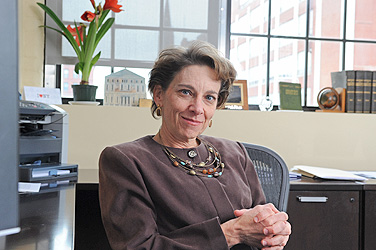News
Regional Institute moves to Gateway

Kathryn Foster says the Regional Institute’s new offices in the UB Downtown Gateway will improve collaboration among the unit’s employees, as well as its community partners. Photo: NANCY J. PARISI
-
 Print
Print -
 Comments
Comments
-
“We are now in the corridor of the government, foundation and business partners who are our collaborators, partners and colleagues.”
UB continues to expand its presence in downtown Buffalo with last month’s move of the UB Regional Institute to the UB Downtown Gateway.
The institute, a unit of the UB Law School that conducts interdisciplinary research and policy studies, moved in mid-November from its former home in historic Beck Hall on the South Campus to newly renovated space on the third floor of the gateway, the former M. Wile Building at 77 Goodell St.
Beck Hall will become the new home to administrative offices, including the Dean’s Office, for the School of Nursing.
The institute plans to celebrate its new home at an open house from 4-6 p.m. Dec. 15.
Also housed in the UB Downtown Gateway are the administrative offices of UBMD, the practice plan for more than 450 faculty physicians, and staff in UB’s new Office of Economic Engagement, a part of the Division of External Affairs.
Other UB programs slated to establish offices at the Downtown Gateway are Government and Community Relations, and the Center for Educational Collaboration, a presidential initiative fostering collaboration with the Buffalo Public School system. The new Educational Opportunity Center building being constructed on Goodell Street will become part of the gateway complex via a common lobby.
Marsha S. Henderson, vice president for external affairs, said the availability of space for these programs in the Downtown Gateway building demonstrates the university’s commitment to working with the neighboring communities as part of the build-out of UB’s presence on the Buffalo Niagara Medical Campus.
The move to Downtown Gateway has been an exciting one for the UB Regional Institutes, notes Kathryn A. Foster, its director.
“I marvel at the tremendous job UB Facilities and the architects have done to create modern offices inside a former industrial building,” Foster says, adding that the space is light and airy, and maintains the building’s terrific structural columns.
“We’re honored and thrilled to be in the vanguard of UB Downtown,” she adds.
In addition to facilitating collaboration among the institute’s 10 full-time employees, two graduate assistants and numerous policy and faculty fellows (Foster says the group was spread among three floors in Beck, and interaction often occurred at the foot of the stairway or at the copy machine), the space downtown will give the institute a “new kind of visibility,” Foster says.
“We are now in the corridor of the government, foundation and business partners who are our collaborators, partners and colleagues,” she says.
Foster notes the institute’s new location downtown will bring “a new kind of synergy” to the unit, which she describes as “having one foot in the academy and one foot in the policy world.”
While the institute will give up the advantages of being on campus, it will gain a new kind of proximity being located near its community partners, she points out. “I believe the benefits outweigh the costs,” she says. “This is a good move for us; it’s good for UB and good for the Regional Institute.”
The institute, which now can be reached at 878-2440, leverages the resources of UB and the binational community to pursue a wide range of scholarship, projects and initiatives that inform regional challenges.
Over the years, the institute has studied problems ranging from vacant properties to air quality, with an eye toward informing debate about good governance. Recent policy briefs have been published on the effects of downsizing local government in Western New York and reorganization of school districts.
The institute’s Region’s Edge initiative focuses on such issues as binational governance and economic integration related to Buffalo Niagara’s unique status as a border region in a global world.

Reader Comments